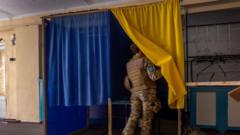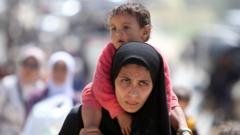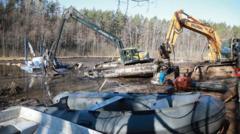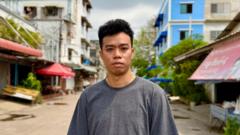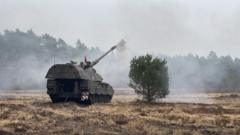Following the devastating 7.7 magnitude earthquake that has claimed over 1,600 lives, Myanmar's military junta persists with aerial bombardments across conflict-affected regions. This relentless aggression prompted strong criticism from humanitarian organizations and international observers.
Myanmar Junta Bombs Amid Earthquake Aftermath: UN Calls for Cessation of Violence
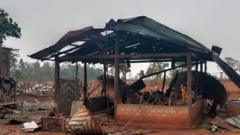
Myanmar Junta Bombs Amid Earthquake Aftermath: UN Calls for Cessation of Violence
Military strikes continue in Myanmar post-earthquake, drawing international condemnation and calls for an end to violence.
The UN's Special Rapporteur, Tom Andrews, condemned the junta's actions, labeling them as "outrageous and unacceptable," particularly amid ongoing rescue efforts. He urged the military to halt operations, emphasizing that anyone with sway over the junta should escalate pressure to end the violence. Pro-democracy armed groups reported airstrikes in the Sagaing region, near the quake's epicenter, and further assaults in areas bordering Thailand.
In a contrasting move, the National Unity Government (NUG), a government-in-exile opposing the military regime, declared a temporary pause on offensive military operations, save for necessary defensive actions in disaster-hit areas. The junta's death toll from the earthquake stands at 1,644, with many believed to be trapped beneath debris.
The earthquake struck after four years of civil conflict, ignited by a military coup in 2021 that ousted a democratically elected government. This led to mass protests and widespread insurrection against the military, which now controls less than a quarter of the country according to recent investigations. Armed resistance groups currently dominate large swathes of land in the Sagaing region.
Historically, the junta has engaged in indiscriminate airstrikes that have devastated civilian infrastructure and claimed countless lives. The UN has raised alarms over the military's actions, suggesting them as potential crimes against humanity, facilitated by ongoing support from Russia and China, which continue supplying the junta with military resources.
Humanitarian efforts are severely hampered by the junta's tendency to weaponize aid, often obstructing access to areas under opposition control. Andrews highlighted the junta's past tactics of denying aid to regions most in need, raising fears that the ongoing situation will reflect similar patterns of manipulation.
As international concern grows, the delicate intersection of natural disaster response and ongoing civil war in Myanmar underscores the immense challenges facing the nation and its people.
In a contrasting move, the National Unity Government (NUG), a government-in-exile opposing the military regime, declared a temporary pause on offensive military operations, save for necessary defensive actions in disaster-hit areas. The junta's death toll from the earthquake stands at 1,644, with many believed to be trapped beneath debris.
The earthquake struck after four years of civil conflict, ignited by a military coup in 2021 that ousted a democratically elected government. This led to mass protests and widespread insurrection against the military, which now controls less than a quarter of the country according to recent investigations. Armed resistance groups currently dominate large swathes of land in the Sagaing region.
Historically, the junta has engaged in indiscriminate airstrikes that have devastated civilian infrastructure and claimed countless lives. The UN has raised alarms over the military's actions, suggesting them as potential crimes against humanity, facilitated by ongoing support from Russia and China, which continue supplying the junta with military resources.
Humanitarian efforts are severely hampered by the junta's tendency to weaponize aid, often obstructing access to areas under opposition control. Andrews highlighted the junta's past tactics of denying aid to regions most in need, raising fears that the ongoing situation will reflect similar patterns of manipulation.
As international concern grows, the delicate intersection of natural disaster response and ongoing civil war in Myanmar underscores the immense challenges facing the nation and its people.

